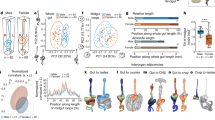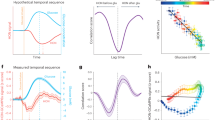Abstract
Ventilation rate and turnover rate of dry air vary among different types of ventilation systems used with individually ventilated cages (IVCs) and can affect the well-being of rodents housed in these cages. The authors compared the effects of two types of IVC systems, forced-air IVCs and motor-free IVCs, on 4-week-old C57Bl/6J male mice. The mice were acclimatized to the cages for 8 d and then monitored for 87 d. Their body weights, food and water consumption and preferred resting areas were recorded. Mice that were housed in motor-free IVCs had a significantly greater increase in body weight than those housed in forced-air IVCs, despite having similar food consumption. Mice in forced-air IVCs had greater water consumption than mice in motor-free IVCs. In addition, mice in forced-air IVCs were more frequently located in the front halves of their cages, whereas mice in motor-free IVCs were located with similar frequency in the front and back halves of their cages, perhaps because of the higher ventilation rate or the location of the air inlets and outlets in the rear of the cage. These results suggest that body weight, food and water consumption and intracage location of growing male mice are influenced by the type of ventilation system used in the cages in which the mice are housed.
This is a preview of subscription content, access via your institution
Access options
Subscribe to this journal
We are sorry, but there is no personal subscription option available for your country.
Buy this article
- Purchase on Springer Link
- Instant access to full article PDF
Prices may be subject to local taxes which are calculated during checkout




Similar content being viewed by others
References
Rosenbaum, M.D., VandeWoude, S., Volckens, J. & Johnson, T. Disparities in ammonia, temperature, humidity and airborne particulate matter between the micro- and macroenvironments of mice in individually ventilated caging. J. Am. Assoc. Lab. Anim. Sci. 49, 177–183 (2010).
Hasegawa, M. et al. Intra-cage air change rate on forced-air-ventilated micro-isolation system—environment within cages: carbon dioxide and oxygen concentration. Exp. Anim. 46, 251–257 (1997).
Höglund, A.U. & Renström, A. Evaluation of individually ventilated cage systems for laboratory rodents: cage environment and animal health aspects. Lab. Anim. 35, 51–57 (2001).
Rosenbaum, M.D., VandeWoude, S. & Johnson, T.E. Effects of cage-change frequency and bedding volume on mice and their microenvironment. J. Am. Assoc. Lab. Anim. Sci. 48, 763–773 (2009).
Reeb, C. et al. Microenvironment in ventilated animal cages with differing ventilation rates, mice populations, and frequency of bedding changes. Contemp. Top. Lab. Anim. Sci. 37, 43–49 (1998).
Clough, G., Wallace, J., Gamble, M.R., Merryweather, E.R. & Bailey, E. A positive, individually ventilated caging system: a local barrier system to protect both animals and personnel. Lab. Anim. 29, 139–151 (1995).
Lipman, N.S., Corning, B.F. & Saifuddin, M. Evaluation of isolator caging systems for protection of mice against challenge with mouse hepatitis virus. Lab. Anim. 27, 134–40 (1993).
Morrell, J.M. Efficacy of mini-containment units in isolating mice from micro-organisms. Scand. J. Lab. Anim. Sci. 24, 191–199 (1997).
Reed-Whitaker, C.K. et al. Control strategies for aeroallergens in an animal facility. J. Allergy Clin. Immunol. 103, 139–146 (1999).
Baumans, V., Schlingmann, F., Vonck, M. & van Lith, H.A. Individually ventilated cages: beneficial for mice and men? Contemp. Top. Lab. Anim. Sci. 41, 13–19 (2002).
Kostomitsopoulos, N.G. et al. The influence of the location of a nest box in an individual ventilated cage on the preference of mice to use it. J. Appl. Anim. Welf. Sci. 10, 111–121 (2007).
Balcombe, J.P. Laboratory environments and rodents' behavioral needs: a review. Lab. Anim. 40, 217–235 (2006).
Würbel, H. Ideal homes? Housing effects on rodent brain and behaviour. Trends Neurosci. 24, 207–211 (2001).
Baumans, V. Science-based assessment of animal welfare: laboratory animals. Rev. Sci. Tech. 24, 503–513 (2005).
Broom, D.M. Animal welfare: concepts and measurement. J. Anim. Sci. 69, 4167–4175 (1991).
Council of European Communities. Council Directive 86/609 on the approximation of laws, regulations, and administrative provisions of the member states regarding the protection of animals used for experimental and other scientific purposes. Off. J. Eur. Commun. L358, 1–29 (1986).
Institute for Laboratory Animal Research. Guide for the Care and Use of Laboratory Animals. 8th edn. (National Academy Press, Washington, DC, 2011).
European Commission. Commission Recommendation on guidelines for the accommodation and care of animals used for experimental and other scientific purposes. Off. J. Eur. Commun. L197, 1–89 (2007).
Nicklas, W. et al. Recommendations for the health monitoring of rodent and rabbit colonies in breeding and experimental units. Lab. Anim. 36, 20–42 (2002).
Castelhano-Carlos, M.J. & Baumans, V. The impact of light, noise, cage cleaning and in-house transport on welfare and stress of laboratory rats. Lab. Anim. 43, 311–327 (2009).
Norton, J.N., Kinard, W.L. & Reynolds, R.P. Comparative vibration levels perceived among species in a laboratory animal facility. J. Am. Assoc. Lab. Anim. Sci. 50, 653–659 (2011).
Krohn, T.C., Hansen, A.K. & Dragsted, N. The impact of cage ventilation on rats housed in IVC systems. Lab. Anim. 37, 85–93 (2003).
Oliva, A.M. et al. Toward a mouse neuroethology in the laboratory environment. PloS One 5, e11359 (2010).
Gordon, C.J., Becker, P. & Ali, J.S. Behavioral thermoregulatory responses of single- and group-housed mice. Physiol. Behav. 65, 255–262 (1998).
Gordon, C.J. Effect of cage bedding on temperature regulation and metabolism of group-housed female mice. Comp. Med. 54, 63–68 (2004).
Lipman, N.S. Microenvironmental conditions in isolator cages: an important research variable. Lab Anim. (NY) 21, 23–27 (1992).
Lipman, N.S. Isolator rodent caging systems (state of the art): a critical view. Contemp. Top. Lab. Anim. Sci. 38, 9–17 (1999).
Acknowledgements
We thank Dr. Arieh Bomzon at Consulwrite for his editorial assistance in preparing this manuscript.
Author information
Authors and Affiliations
Corresponding author
Ethics declarations
Competing interests
The authors declare no competing financial interests.
Rights and permissions
About this article
Cite this article
Kostomitsopoulos, N., Alexakos, P., Eleni, K. et al. The effects of different types of individually ventilated caging systems on growing male mice. Lab Anim 41, 192–197 (2012). https://doi.org/10.1038/laban0712-192
Received:
Accepted:
Published:
Issue Date:
DOI: https://doi.org/10.1038/laban0712-192
This article is cited by
-
Maternal immune activation: reporting guidelines to improve the rigor, reproducibility, and transparency of the model
Neuropsychopharmacology (2019)



